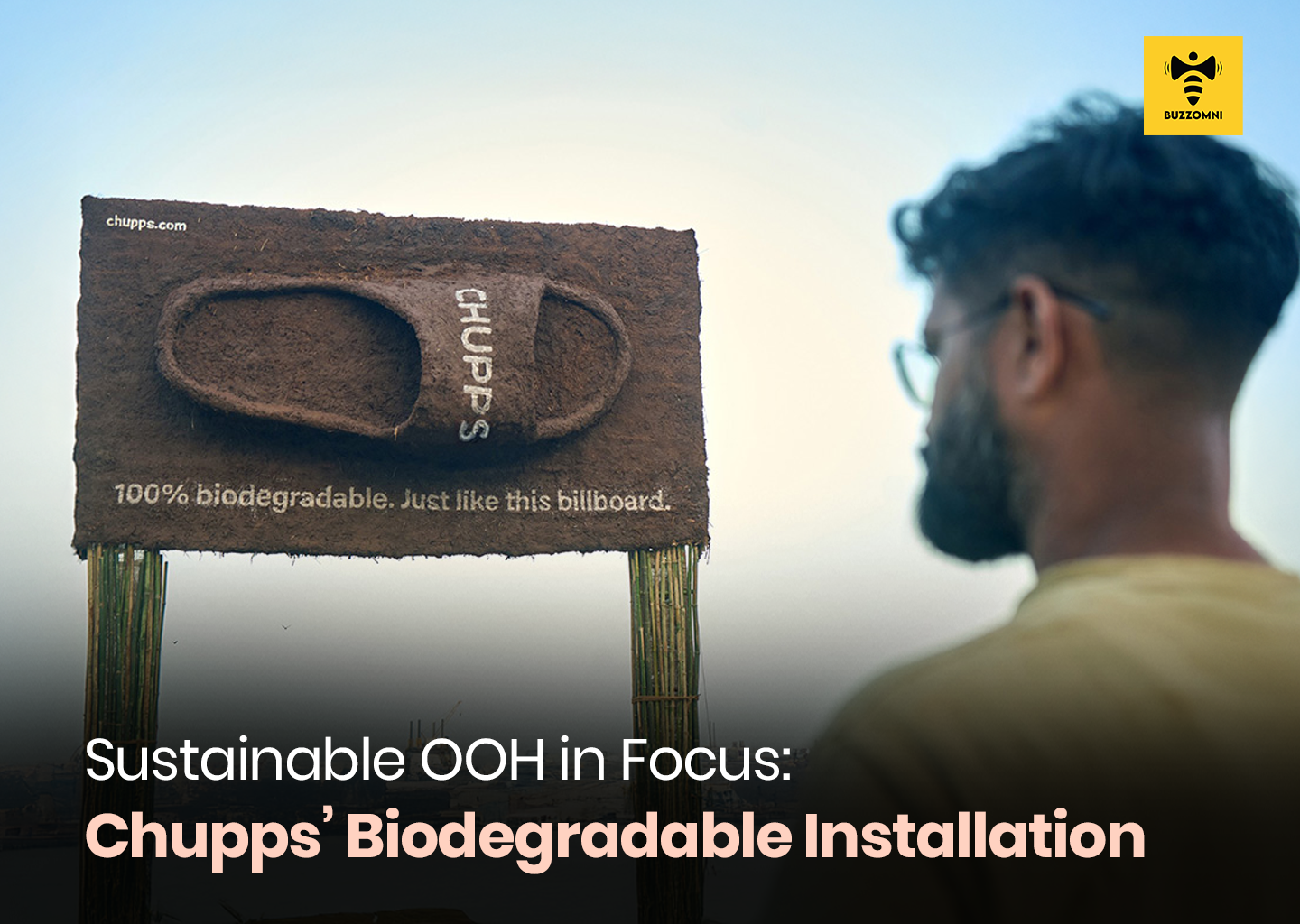A New Era for OOH – Chupps Inspires Advertising That Gives Back to the Earth
Chupps’ biodegradable billboard in Mumbai showcases how outdoor advertising can be innovative, sustainable, and true to a brand’s values. Made from natural materials, it dissolves in the rain—mirroring the lifecycle of the brand’s biodegradable footwear.

Table of Contents
- Introduction: Sustainability Is Reshaping OOH
- Chupps’ Biodegradable Billboard: Advertising That Disappears
- Why This Is a Milestone in OOH Innovation
- What This Signals for the Future of OOH
- Challenges—and the Potential to Scale
- Why BuzzOmni Celebrates This
Introduction: Sustainability Is Reshaping OOH
In a world where sustainability isn’t just a buzzword but a business imperative, outdoor advertising (OOH) is also evolving. Gone are the days when billboards were mere static hoardings made of plastic, vinyl, and metal—not always in sync with eco-conscious brand values. The latest innovation from Chupps Footwear proves that OOH can be more than just eye-catching—it can be earth-friendly.
Chupps’ Biodegradable Billboard: Advertising That Disappears
Chupps Footwear has launched what is being hailed as India’s first biodegradable billboard in Bandra, Mumbai, crafted entirely from natural, organic materials: bamboo, clay, sawdust, hay, and natural rope.
Here’s what makes this campaign revolutionary: when it rains, the billboard starts to disintegrate, leaving behind only its bamboo frame—the rest dissolves back into the earth.
This isn’t just creative symbolism. It’s a literal, physical manifestation of Chupps’ product philosophy: their new “True Zero” line of sliders is 100% biodegradable, designed to break down in landfill conditions within 24 months.
Why This Is a Milestone in OOH Innovation
- Authentic Brand Storytelling: The billboard isn’t just a backdrop—it’s a metaphor. Chupps isn’t making claims about biodegradability—they’re showing it. By using organic materials and letting the structure disintegrate, they bring their core promise to life in the most honest way.
- Sustainable by Design—From Product to Promotion: Often, sustainability campaigns focus only on the product, while ignoring the footprint of the message itself. Chupps flips that. Their marketing medium is as thoughtfully crafted as their footwear.
- Impactful Storytelling in High Visibility Spaces: Placing the installation in a high-visibility area near Bandra Bandstand ensures people see not just the message, but the transformation over time. It’s a physical performance of nature reclaiming — and that’s rare in OOH.
- Aligning with Younger, Conscious Consumers: The campaign is strategically targeting the 16–35 age bracket—a demographic that's more open to sustainability, innovation, and brands that “walk the talk.”
- Affordable Sustainability: What’s even more compelling: Chupps has managed to keep their biodegradable footwear range affordable, challenging the notion that sustainability has to be premium.
- Lifecycle Accountability: The billboard literally has a lifecycle—it disintegrates just like the shoes it promotes. This closes the loop in messaging: the brand is not just conscious about how things begin, but also how they end.
What This Signals for the Future of OOH
Chupps’ campaign is not just a one-off stunt. It’s a vision of a new age of OOH, where:
- Brands don’t just broadcast; they biodegrade.
- Campaigns are transient by design, leaving no toxic trace.
- Innovation is not only technological (digital screens, rotating fans) but biological — rooted in natural systems.
- Advertising becomes a participant in the circular economy, not a fossil-fuel-powered monolith.
For creative agencies, media owners, and brand marketers, this opens up a powerful opportunity: to rethink OOH not simply as communication to last, but as a medium built to naturally return to the earth.
Challenges—and the Potential to Scale
Of course, making a biodegradable billboard isn’t easy. Chupps and INTO Creative reportedly dealt with:
- Sourcing skilled artisans familiar with organic, clay-based materials.
- Navigating permissions for non-conventional structures.
- Ensuring structural longevity until the billboard fulfills its purpose.
Yet, if the Bandra installation is well received, Chupps plans to replicate it in other cities. That means this could become more than a campaign—it could be a template for eco-OOH.
Why BuzzOmni Celebrates This
At BuzzOmni, our mission is to champion smart, meaningful media—and Chupps’ biodegradable billboard is one of the most powerful examples we've seen lately. It’s not marketing for the sake of noise; it’s communication that aligns with the planet and the brand’s DNA.
This is the new age of OOH: brave, biodegradable, and built to leave gracefully.



